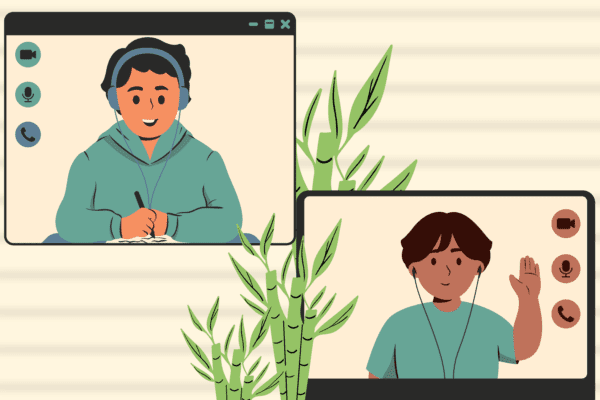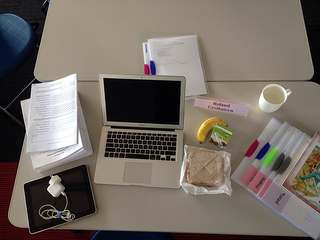What’s different and not surprising:
Deadlines: There aren’t any in tutoring. Does that mean there’s no stress involved? No, but there is near zero of the freneticism that comes with having multiple deadlines every single day when you’re teaching multiple groups and/or multiple topics. Anyone who does any kind of presentation knows it’s all about preparation. It’s not quite true that there is no prep involved in tutoring, but let’s face it, when you’re tutoring on a topic with which you’re already familiar, a lot of prep work has already happened gradually over the course of the years spent teaching it. And I do spend some time organizing material just in case a student opens with “I’m not clear on trig, but I don’t have any examples to work on,” which does happen. But other than that, prep time is zero, and of course, there are no deadlines for report cards or corrections.

Focus: There’s a ton of that in tutoring, not just because we’re one-on-one, but also because we’re usually only working on one specific topic at a time. It’s the ultimate just-in-time activity, about as personalized as you can get. I do not mean that focus was absent in my classroom. There are skills that I emphasized in a general sort of way as a teacher, but which I can now follow through on with just one individual student. For example, slowing down while you work, doing things twice, estimating, mental math tricks (finding 16% of 25 by instead finding 25% of 16!), and organizing info – not just formulas but when to use which one.
One wonderful gift that such focussed attention has bestowed: We teachers love witnessing a student’s aha moment, where their eyes suddenly light up and they say something like OH I GET IT NOW. I don’t have any data on how often that happened in my class, but it was rare enough that when it did happen, I floated on it for… a while. I never got enough of that. Well, in tutoring, it happens a lot more often!
The students: Many of the students who arrive for tutoring need help not only in their math skills but also in self-diagnosing, although that word implies that something has gone wrong – maybe a better word would be self-assessment. It’s not always about the math. At some point, we all need to take stock of our growth. That involves categorizing three things, according to Blake Harvard: Knowing what you know, knowing what you don’t know, and discovering what you don’t know you don’t know. (I know. That’s a lot of know’s.) More than once, when a student has arrived with no specific questions, we’ve spent our time doing a quick overview of a unit, kind of like a here’s-what-you-should-have-on-your-memory-aid list, and it’s helped to reveal some gaps, not to mention shine a light on the bigger picture.
The surprises:
Edtech. There’s nearly none of that in tutoring. Of course, there’s the tech involved in meeting and communicating online, and there’s a whiteboard we can both annotate, but I’m talking about my favourites, like Desmos, GeoGebra, Graspable Math, etc. My lessons evolved over the years to include many of these types of activities, in fact, over time, the activity BECAME the lesson. I fully believe that I would not have been the same teacher without these platforms. But tutoring has forced me to do without! Since each tutoring session is only a half hour, there’s no time to do much other than what is immediately on the student’s mind. Also, in my experience, among the best practices for using my favourite tech tools is giving the student time to become familiar with it, which can take weeks. That’s out of the question in the tutoring timeframe, especially if a student is only there for one session. Even if they’re regulars, it’s pretty dicey time-wise. However, there was actually one time when a student asked if we could work on a Desmos activity that he’d tried to do in class. He didn’t have any kind of link to it, only that it was “something about zapping”, which was enough for me to identify it as this Desmos-created activity about solving linear systems. It was epic! After we worked through it together, he exclaimed something like “Wow that was so fun, and I get it now!” I can only hope that might happen more often, as more teachers make use of this uniquely wonderful tool.
The students: It’s not only kids who struggle with math who come for tutoring. Admittedly, the majority of my tutees are there because they need support to complete their math homework or develop their skills, which is kind of the point. But I have plenty of kids who clearly have great skills, and are there for something else. Sometimes it’s plain reassurance. They’ll work something out perfectly and ask me if it’s right. Or they’ll ask me wonderful “What if” questions – What if the quadratic equation isn’t factorable? What if it’s not an isosceles triangle? They’re forging their own learning path, perhaps out of insecurity, or a natural inclination to fit things into a bigger picture. Either way, it’s meaningful and important support.

As a math student, a “strong” one, I would have LOVED to have had a tutor. I wasn’t afraid to ask questions in class, but they didn’t usually occur to me until later. There were some questions that I didn’t even know how to formulate. For example, I remember when we were doing something called “antilog”, way back when such things were necessary because there were no calculators (yes, reader, I am THAT old). Even though I could get the right answers, I didn’t really know what “taking the antilog” meant, and I didn’t have the maturity to weave the seemingly separate concepts of logarithms and antilogarithms into a meaningful tapestry. If I’d had access to a tutor that likely would have been the kind of help I would’ve asked for.
Webcam: Most students who come for tutoring voluntarily turn on their webcams without hesitation, whereas my classroom students almost never did. It may seem obvious that, everyone, teenager or not, would likely be more comfortable revealing themselves to one person than a group, but this was still a welcome surprise to me because in order to create a safe space, I never once required anyone to turn on their webcams. It seems that in the one-on-one setting, that safety element was already there.
Commonalities
Situational problems: In Quebec one of the math competencies we assess is solving something called “situational problems.” These are generally multistep, long-term problems that involve many skills. It is much more involved and more difficult than anything I had to do when I was a student. Many students, those I had in my class as well as those I tutor, need coaching on how to work through a situational problem. When someone arrives at tutoring with one of these to do, it’s impossible to work through the whole thing with them in our half hour. Instead, I try to give them a plan of action, which includes how to start, how to keep moving, how to organize their work, and how to make their thoughts more comprehensible to whoever is reading it.
Therapy: Whether as a teacher or tutor, I often feel like a therapist or a mental health interventionist. Many students, good marks or not, are stressed about math, and some are even traumatized. I find myself using the same language in either setting to overcome that obstacle: Wow that’s an excellent question, I know what you mean, Hello fellow mathematician, etc – always emphasizing that they know a lot more than they think they do, and what they think MATTERS. As a teacher, I felt like a nurse, and as a tutor, a doctor. With all that class prep time, I was foreseeing and removing obstacles, planning for the long term, checking in with them, and keeping them on the path of growth. As a tutor, I’m intervening to correct, or to provide additional support where something seems to have faltered.

In a perfect world, the ideal combo would be for every student to have both a teacher and a tutor on their team. (Side note: My own kids theoretically had that because their mom was a math teacher. Helping my own kids with their math worked out really well, said no parent ever.)
The relationship: The relationship is still so important. In either setting, students need to feel comfortable enough with me to ask questions or to respond to my prompts. Surprisingly, that happens just as quickly and organically during tutoring as it does in the classroom. My theory as to why that is – is math-based of course. In the classroom, we have a lot more time to develop that relationship, but it’s somewhat diffused over the 30 or so students in the room, whereas in tutoring, the one-on-one ups the concentration to the maximum! It also helps that almost all of my students are regulars, that is, I see them once a week. I’ve been introduced to their pets (via the aforementioned webcam), learned when it’s their birthday, or heard about something exciting that happened, just as has happened in class.
What I miss:
Strangely enough, one thing I do miss about teaching is that same freneticism that those multiple deadlines generated! It was so exciting to come up with an idea for a new activity, then take it from idea to actual Desmos, GeoGebra or Graspable Math. Even before a single student had eyes on it, there was a huge amount of creativity involved in shaping an activity (mine and that of colleagues who invariably contributed) in forging the math, the pedagogy, and the fun into a math period! And most of the time, I would be tweaking it right up until minutes before class, because that’s when my best ideas tended to arrive. The adrenaline was fairly exploding in my veins. I miss that. Of course, I can still develop activities, in fact, I do, and it’s still exciting, but I often wonder if they’re as good as they might have been with that live-class carrot. I’m sure I’m missing something without that class-time-deadline because it triggered some pretty great out-of-body inspiration if I do say so myself.
What I thankfully don’t have to miss:
I’m fortunate that I don’t have to say I miss the students because I still have them – a lot of them! And what was true for teaching is still true for tutoring; If you play your cards right, you get all the positive reinforcement you need from your students. I am, after all, still a human, and I still need that affirming feedback as I do what I still feel I was meant to do, to help young people grow as mathematicians.
Photo credits:
Featured image by Mohamed Hassan
Alarm Clocks by Alexas Fotos
E-learning by Moondance
Brain/Heart by Gordon Johnson






What a wonderful look you have give us into you as a teacher, into the joy and excitement of teaching and the human quality of the student-teacher relationship. Computers will never give the students the wholesomeness of the experience. So glad you’re still around and kicking in education.
Thank you so much for reading Christiane, and for your insight!